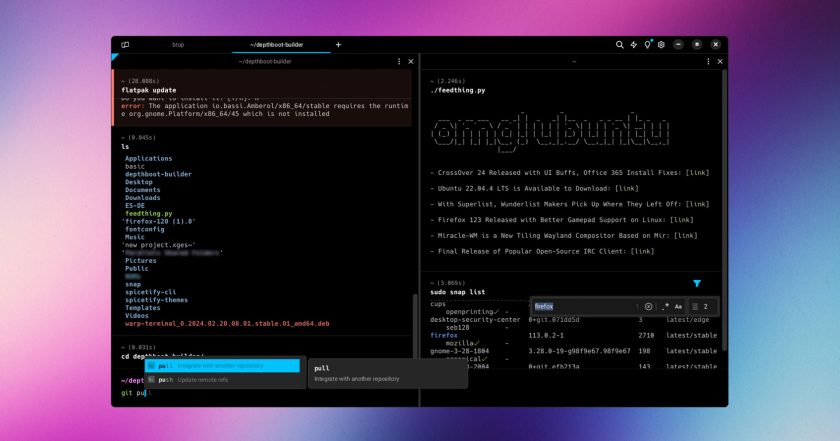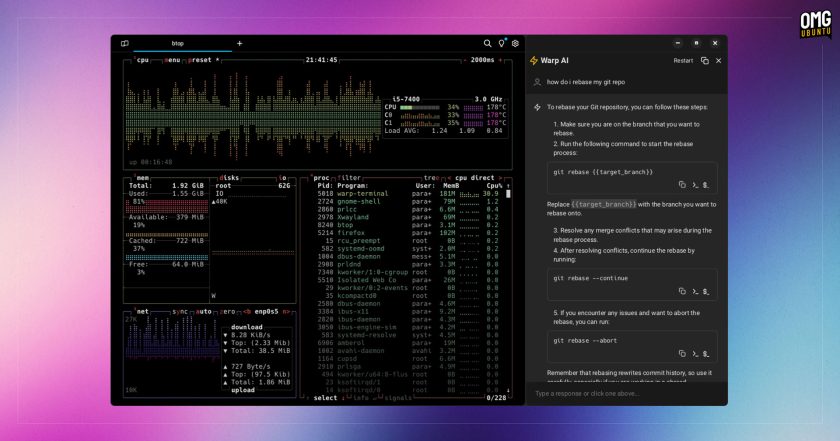Linux developers have a new toy to play with, Warp.
Warp is a (currently) closed-source terminal emulator built using the Rust programming language.
It offers hardware acceleration, integrated AI, collaborative capabilities, and uses a “block” based approach to group commands and output that help set it apart from traditional console-based tools.
Plus, when it comes to text input Warp functions more like an IDE or text editor by offering filtering and selections, cursor positioning (including multiple cursors), auto-completion, syntax highlighting, and more besides — the following video gives a good overview:
Previously a Mac-only app, Warp is now available for Linux distributions, including Ubuntu.
At launch, Warp’s Linux app already offers the same features of the Mac version (it shares 98% of the underlying code) plus slightly better performance thanks to additional optimisations specific to the Linux build (but coming to Mac in a future update).
Warp is not an Electron app (phew). It’s built using open-source Rust libraries (including, notably, System76’s cosmic-text), and bug fixes and other tweaks are upstreamed. It also makes use of its own Rust-based UI framework which the company plans to open source.
As Warp supports zsh, bash and fish so it should work “out of the box” with most existing shell setups — though chances are someone with a niche complex exception will “actually…” that claim!
The app also has a selection of default themes (and support for creating custom ones), configurable keyboard shortcuts, supports vertical panel splitting, and many other common “terminal emulator” features most will be familiar with.
- IDE-style text input/navigation
- Block-based command grouping
- Ability to save and share commands
- Warp AI can generate commands from normal text
- Customise keybindings and launch configs
- Built-in themes + support for custom ones
Warp’s integrated AI can be used to generate commands from a natural language prompt, debug errors, or remind you about a command you’ve forgotten.
And the Warp Drive (they had to use that name somewhere, right?) features let you make the terminal collaborative. You can save commands as reusable workflows, share them with others, and more.
Who is Warp for?
As powerful and as innovative sounding as Warp terminal is, and as excited as I am to see it land on Linux (choice is always a win), it’s not aimed at “regular” users like myself.
I use the terminal a fair bit, but mainly for things like running apt, snap and flatpak commands, checking system resource usage, listening to music in a CLI music players, and the odd bit of compiling from git repos — stuff for which Warp is arguably overkill.
It’s the AI, collaborative, and productivity-aiding features that make this terminal so (comparatively) unique. Thus it’ll be heavy, rather than casual, terminal users who find the most benefit from them. People who spend a significant amount of time working at the console.
“Linux is a uniquely important platform for developers, and the terminal is a uniquely important tool on Linux. The terminal is often the primary, and sometimes the only, way that developers use Linux machines,” say the company behind the app.
“Despite this, Linux has relatively few terminal options compared to Mac and Windows, and none with the modern features of Warp. We hope the addition of Warp as an option today unlocks a bunch of new productivity and happiness for individuals and teams spending their days in the Linux console.”
Download Warp for Linux
A Linux version of Warp has been in great demand, with Linux support being one of the most upvoted issues on the Warp GitHub page.
If you fancy seeing if the hype is justified, you can download Warp for Linux with a DEB installer provided for Ubuntu (which adds the official Warp APT repo). There’s also an AppImage if you’d rather use that, and packages for other distros are also available.
Be aware you need to sign up for a (free or paid) account to use the app. There is a privacy policy (which is mostly reassuring to their credit) to be aware of, and you need to have an active internet connection to actually open and use the thing.
I can’t lie: the notion of needing to log in to an online account to access a terminal to run commands locally on my own computer feels a little bit warped — but the bulk of the features included do leverage cloud-based services so I guess it’s not so bizarre in context.
It’ll be will be interesting to see how this application is received by the Linux community. Closed-source codebase and “freemium” business models typically attract short-shrift.
But its feature set and workflow integrations are novel, and may potentially be something other terminal apps decide to ape in time…
• Get Warp for Linux
Thanks Filmm


